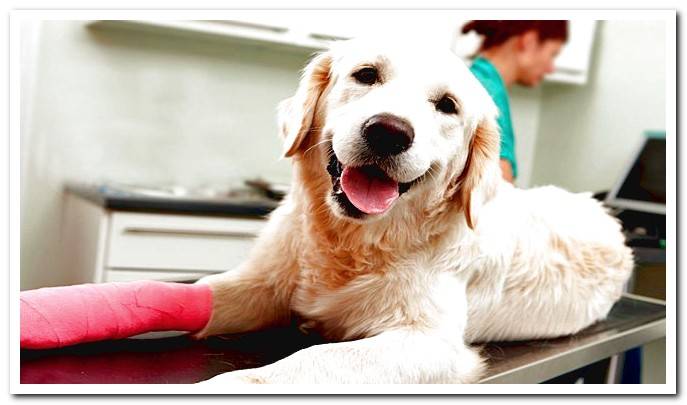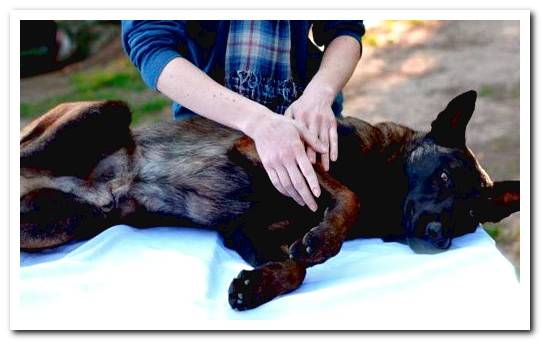
Humans and dogs share very similar conditions, an example of this is arthritis. In both cases, age is an important factor for the development of this disease, although there are other causes of arthritis in dogs that you should know and prevent.
So that you can recognize this problem if your dog suffers from it, we will explain what the usual symptoms are and what we can do to help you avoid the pain that arthritis causes.
Index of contents
- 1 What is arthritis and how does it affect my dog?
- 2 Things that cause arthritis in dogs
- 3 Main symptoms of arthritis
- 4 How is canine arthritis treated?
- 5 Tips for caring for a dog with arthritis
What is arthritis and how does it affect my dog?
Arthritis is a very common degenerative condition in dogs that affects the joints. With the age cartilage begins to wear down and osteophytes appear, which are excessive bone proliferation in certain areas.
To give you an idea: an osteophyte is a piece of bone that almost always grows in a joint and is an attempt by the dog’s body to increase the support surface between two joint pieces, or the result of calcification of the tissues soft.
Symptoms get worse over time, especially if arthritis is not being treated properly. In order to identify it, let’s first see what the main causes are.

Things that cause arthritis in dogs
Dog age is one of the most common causes of canine arthritis, but not the only one. Among the main factors to take into account, the following stand out:
- Dog Aging: From 8 years of age, the dog’s chances of suffering from arthritis increase considerably. This is due to the natural wear and tear of the bones after a lifetime of adventure.
- Excessive dog weight: Being overweight is another factor that can cause or worsen arthritis, because the joints must bear more weight than they should. Make sure the dog is not overweight to prevent the onset of arthritis.
- Dog genetics: Genetics is a lottery and some furry are born with a greater predisposition to arthritis; especially if their ancestors have had problems of this type. Previous operations: If the dog has undergone joint surgery throughout its life, it could develop arthritis more easily when it reaches old age.
- Very interesting: 10 signs that tell us that our dog is getting old
If a dog meets one or more of the conditions just described, be alert to arthritis symptoms and don’t let your guard down. Early detection will be essential to avoid pain and complications.
Main symptoms of arthritis
The most obvious symptoms of arthritis in dogs, indicating that joint degeneration is occurring, are as follows:
- The dog lags behind when going for a walk, it does not advance at the same pace as before.
- He is stiff and has trouble getting up in the morning.
- Limps.
- He is not very interested in playing and has difficulty running, walking or climbing on the bed and sofa.
- He has trouble climbing stairs.
- Shows signs of pain and moans or complains when touching his paws; also when scratching or licking.
- Sometimes you can show some aggressiveness, because of the pain you experience
- Your mood is not good
- Does not eat as usual
- He is more distant
- His eyes lose their shine
If you detect any of these physical or behavioral changes, do not hesitate to take it to the vet as soon as possible.

How is canine arthritis treated?
When you bring the dog to the veterinary office, the specialist will examine its clinical history and perform a physical examination to confirm or rule out this diagnosis. It is important that you mention each and every one of the symptoms that you have observed, even if they do not seem serious.
After being sure that it is canine arthritis, the vet will recommend the most appropriate treatment. Normally it will be pharmacological treatment, using non-steroidal anti-inflammatory drugs and some supplements such as glucosamine or chondroitin.
Heed what the vet tells you and, above all, do not even think of self-medicating or giving arthritis medications prescribed for humans. This could poison you and make your condition worse.
Tips for caring for a dog with arthritis
Along with the treatment indicated by the vet, once at home you can help the dog with arthritis in multiple ways. Some tips for caring for a dog with arthritis are:
- Provide him with an orthopedic dog bed. So you can rest more comfortable.
- Put your food and water containers higher, so you don’t have to duck as low.
- When strolling, choose soft or dirt surfaces.
- Control your diet so that you stay within your ideal weight. If you weigh more than you should, arthritis can get worse.
- make a daily massage on the dog’s back, neck, knees, hips and paws, very carefully. This will decrease stiffness and make you feel more relieved.
- Do not let him sleep on the floor, because the cold will increase his pain. Also make sure it is protected from drafts.
- Try not to climb too many stairs and, if you can, set up ramps to make it easier to move without pain.
Follow these recommendations and don’t forget to take your dog to regular check-ups with your vet to keep arthritis at bay. In this way, it is sure that the quality of life of our furry with arthritis improves and they will be happier and happier despite this degenerative disease.
